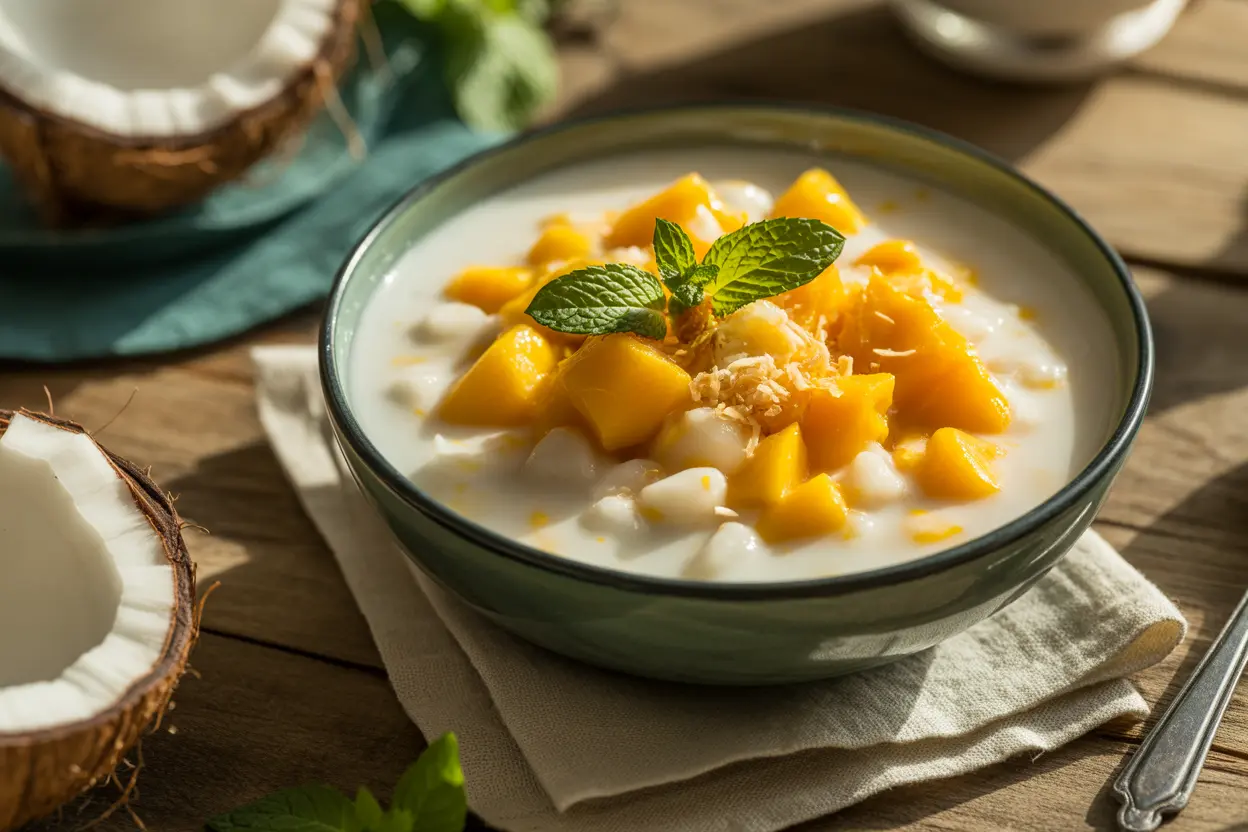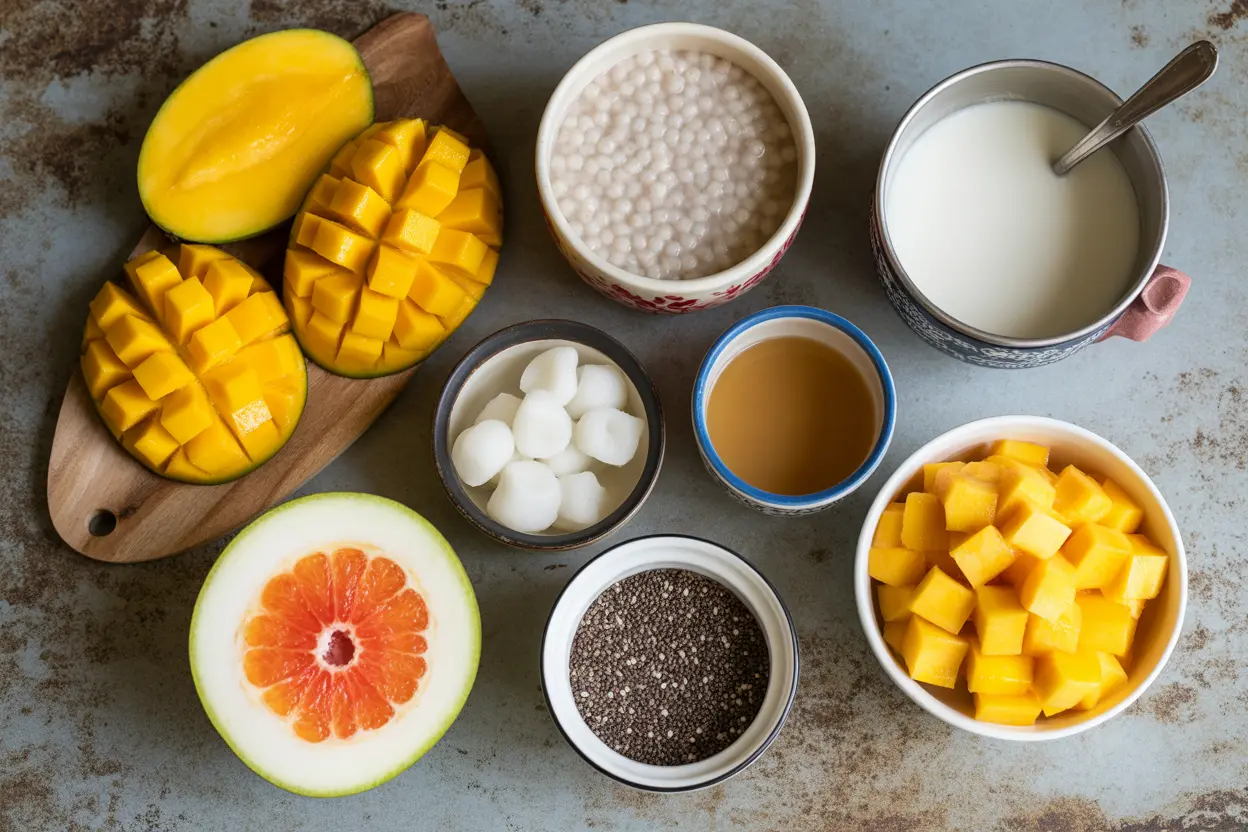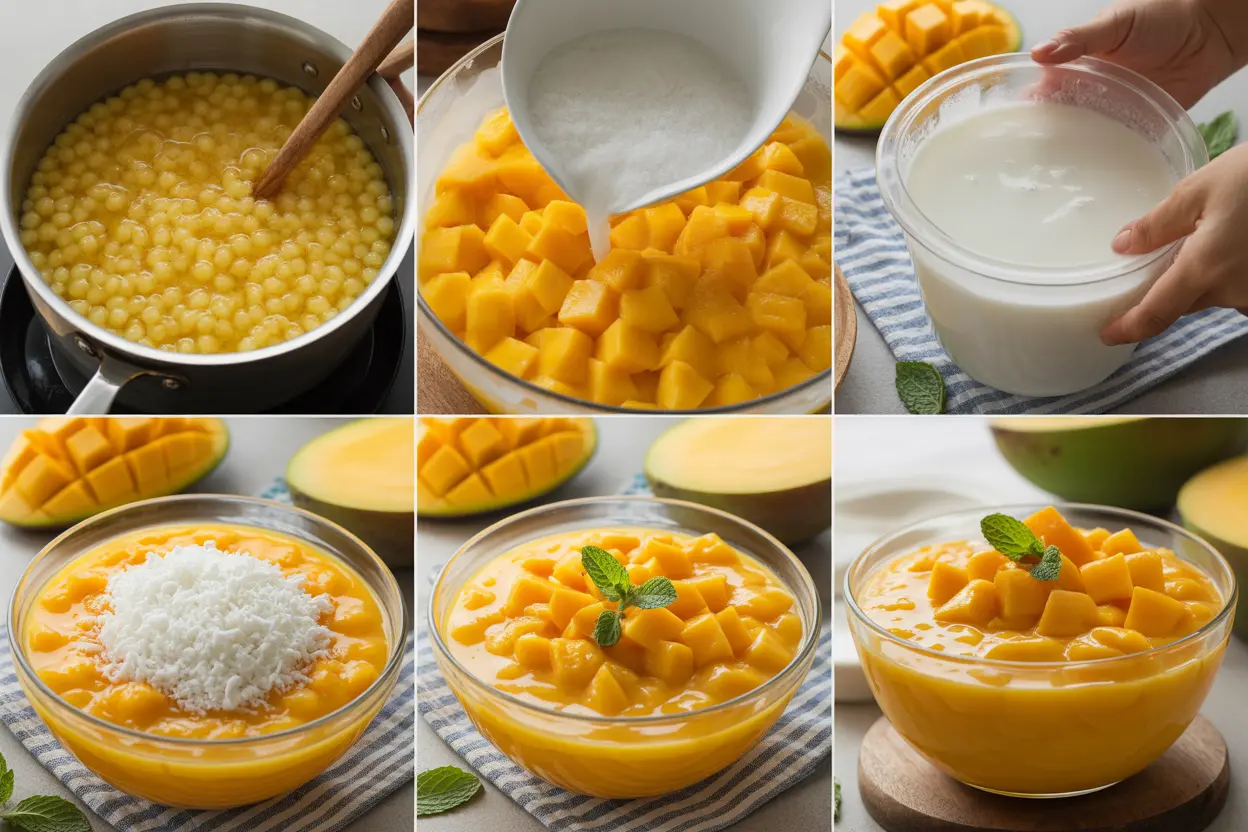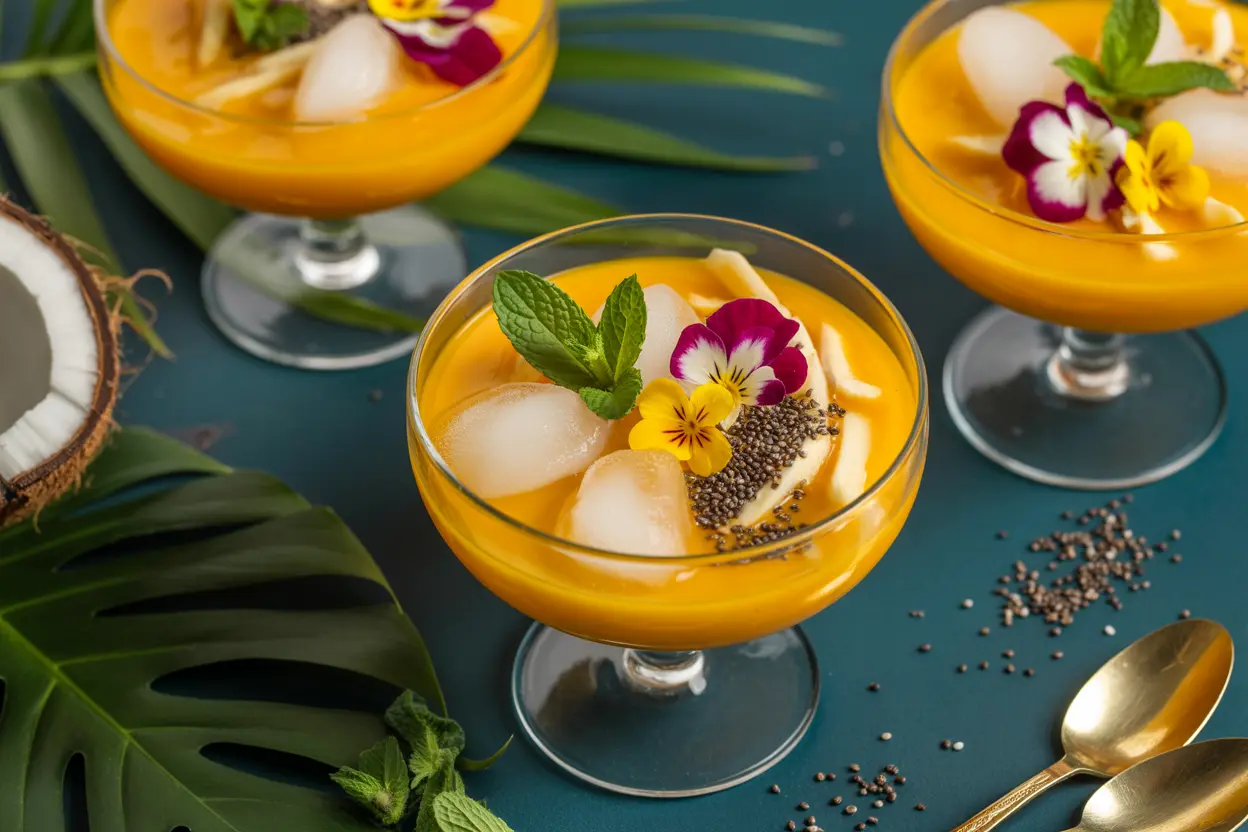Introduction to Mango Sago
What is Mango Sago?
If you’ve ever craved a tropical fruit dessert that’s both refreshing and satisfyingly chewy, you’re in for a treat with this mango sago recipe. Mango sago is a classic Asian dessert featuring a luscious blend of sweet mangoes, tapioca pearls, and creamy coconut milk. Imagine a dessert that feels like a warm tropical breeze—sweet, smooth, and with just the right pop of texture. This recipe is an absolute must-try if you adore mango dessert dishes that combine classic flavors with a fun twist.

Origins and Popularity
Mango sago traces its roots primarily to Hong Kong, where it became a beloved staple in the realm of Asian cuisine. Thanks to its appealing taste and ease of preparation, it has gained widespread popularity beyond Asia, especially as a delightful summer dessert to beat the heat. The marriage of condensed milk, chewy tapioca pearls, and vibrant mango chunks creates a dessert experience that’s both traditional and fresh. Curious about the combinational magic of mango and coconut milk health benefits? It’s an enticing duo that elevates this dessert to a whole new level of flavor and nutrition.
Ingredients for Mango Sago
Essential Ingredients
The foundation of this mango sago recipe hinges on a few star ingredients that come together to create its signature taste. You’ll need:
- Ripe mangoes, providing natural sweetness and bright color.
- Tapioca pearls, which give that iconic chewy texture.
- Coconut milk for creaminess and tropical undertones.
- Condensed milk to add a decadent sweetness.
Each ingredient is integral in crafting the perfect balance between creamy and fruity. For those curious about the precise balance, feel free to explore the key ingredients and their variations to customize your dessert.

Optional Add-ons and Variations
Want to shake things up? You can always add:
- Pomelo or other citrus fruits for a hint of tartness.
- Chia seeds for extra texture and health benefits.
- Frozen mango cubes, a convenient alternative if fresh mangoes aren’t in season. Check out the guide on using frozen mango for preparation to keep your dessert delicious year-round.
Step-by-Step Mango Sago Recipe
Preparing Tapioca Pearls
Cooking the sweet tapioca pearls just right is crucial. Start by boiling water in a large pot—make sure there’s plenty to allow the pearls to swim freely. Once boiling, add the pearls and stir gently to prevent clumping. They typically cook for about 10-15 minutes or until they turn translucent, bouncing along with a delightful chewiness. For an expert trick on timing and texture, check out this detailed tapioca pearl cooking guide. Once cooked, rinse them under cold water and set aside to avoid overcooking.
Preparing the Mangoes
Select mangoes that are ripe, fragrant, and vibrant orange. Peel and dice the mango flesh, reserving some chunks for garnish if you like. For a smoother dessert, blend a portion of mango into a puree—this gives your mango sago an extra burst of flavor and color. The consistency of the mango plays a huge role in the final texture, so take your time perfecting it.
Making the Mango-Coconut Milk Mixture
Here’s where the magic happens! Combine the coconut milk and condensed milk in a bowl, mixing until smooth and creamy. Add in the mango puree and blend to integrate all the flavors. This luscious mixture is what gives mango sago its iconic tropical fusion taste. For more on the combined effects of mango and coconut milk, you’ll love diving into their health benefits alongside exquisite flavor.

Combining and Serving the Mango Sago
Now, fold the tapioca pearls gently into the mango-coconut mixture, ensuring an even distribution of chewy tapioca and velvety mango goodness. Chill the dessert for at least an hour—serving it cold enhances the refreshing aspect, perfect for a hot day. When ready, transfer into pretty bowls and garnish with reserved mango chunks or other toppings of choice.
Tips and Tricks for Perfect Mango Sago
How to Cook Tapioca Pearls Correctly
Getting perfect tapioca pearls can feel like an art. Always use plenty of water and avoid crowding the pearls—this helps them cook evenly and stay separate. Stir occasionally to keep them from sticking to the bottom. After cooking, rinse with cold water immediately to halt the cooking process, which maintains their distinct chewy texture. For even more guidance, the how to prepare tapioca resource is a lifesaver.
Adjusting Sweetness and Texture
Everyone’s sweet tooth differs! Feel free to tweak the amount of condensed milk or coconut milk in your mango sago to suit your taste. Want it creamier? Add a splash more coconut milk. Prefer a lighter version? Cut back on condensed milk or swap for a low-sugar alternative. It’s all about finding the perfect harmony for your palate.
Variations to Suit Dietary Preferences
Looking for a healthier or vegan twist? Mango sago can easily embrace dietary swaps by using coconut condensed milk or natural sweeteners like agave syrup. Plus, it aligns well with plant-based diets without sacrificing its lush creaminess.
Serving Suggestions and Presentation
Best Serving Temperature
Mango sago shines brightest when served chilled. The cool temperature amplifies the fresh mango flavors and balances the richness of the coconut milk. Whether straight from the fridge or with a few ice cubes, it’s the ideal pick-me-up during warm weather.
Garnishing Ideas
Want to wow guests? Sprinkle some toasted coconut flakes, fresh mint leaves, or tiny edible flowers atop your dessert. For inspiration, explore these dessert garnishing ideas that add visual and flavor appeal. Adding a few chia seeds or vibrant fruit slices can elevate the experience from simple to stunning!

Nutritional Information and Health Benefits
Calories and Macronutrients
A typical serving of mango sago offers a balanced blend of carbohydrates from mangoes and tapioca pearls, fats from coconut milk, and a hint of protein. While it is a sweet treat, you can moderate sweetness to suit your energy needs and dietary goals. It packs a tropical punch with natural sugars alongside creamy textures, making it a guilt-free indulgence when enjoyed mindfully.
Potential Health Benefits
Mangoes are rich in vitamins A and C, contributing to immune support and skin health. Combined with the healthy fats in coconut milk, this dessert provides more than just pleasure—it brings nutritional benefits, too. Dive deeper into the nutritional benefits of mango for a detailed look at how this delicious fruit supports overall well-being.
Variations and Alternatives
Dairy-Free and Vegan Options
Luckily, this mango sago recipe is naturally compatible with vegan diets, especially with coconut milk taking the creamy lead. You can use plant-based condensed milk alternatives or sweeten with maple syrup for a dairy-free version that doesn’t skimp on flavor.
Fruit and Flavor Substitutions
Feel adventurous? Try swapping mangoes with ripe peaches, papaya, or even mixed tropical fruits to give your dessert new character. Each substitution lends its own charming sweetness and texture, perfect for personalizing your tropical indulgence.
FAQs
What type of mango is best for mango sago?
For the best flavor and texture, pick ripe, sweet mangoes like Ataulfo or Alphonso varieties. These mangoes are buttery and fragrant, perfect for creating that luscious mango puree and vibrant chunks most crucial in this dessert. Avoid unripe or fibrous mangoes to keep your mango sago smooth and enjoyable.
How do you know when tapioca pearls are fully cooked?
Fully cooked tapioca pearls turn from opaque to translucent and become delightfully chewy without any hard centers. Cooking time varies by pearl size but generally takes around 10-15 minutes of boiling. Use a spoon to taste-test—they should be soft but with a satisfying bounce. For foolproof results, refer to a trusted tapioca pearl cooking guide.
Can mango sago be made ahead of time?
Absolutely! Mango sago tastes even better after resting in the fridge for a few hours, letting flavors meld beautifully. Just keep the tapioca pearls separate if you plan to store it more than a day to prevent them from becoming too soft. Check out tips to keep your dessert fresh to maintain its perfect texture.
Is there a vegan version of mango sago?
Yes! By using coconut milk and plant-based sweeteners like maple syrup or vegan condensed milk, you can create a completely vegan mango sago. The richness of coconut milk ensures you won’t miss the dairy, making this tropical dessert a great choice for plant-based eaters.
How can you adjust the sweetness of mango sago?
Adjust sweetness by varying the amount of condensed milk or choosing alternatives such as honey, maple syrup, or agave nectar. Taste as you go, adding sweetener gradually. You can also use unsweetened coconut milk and rely more heavily on the natural sweetness of ripe mangoes for a lighter dessert.
Conclusion
Mango sago is a delicious and refreshing tropical dessert that combines sweet mangoes, chewy tapioca pearls, and creamy coconut milk to create a harmonious and satisfying treat. By following the simple steps outlined and customizing the ingredients to your taste, you can easily prepare this popular Asian dessert at home. Whether for a summer party or a casual snack, mango sago is sure to delight. Remember to cook tapioca pearls properly, adjust the sweetness to preference, and serve chilled for the best experience. Experiment with the mango sago variations to make this classic recipe your own culinary signature.

1 thought on “Mango Sago Recipe: Easy & Creamy Tropical Dessert”